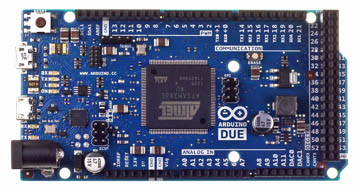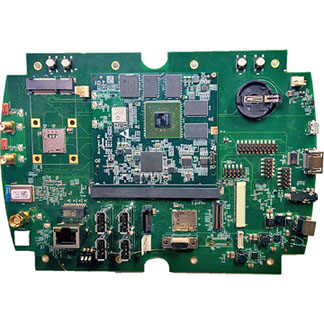There is an absolute wealth of single board computers available now. Boards with every sort of CPU and I/O. Let’s just have a look and a few that are based on some form of ARM processor.
A look at the ARM Connected Community site finds a table (http://goo.gl/na3rUF) of ARM powered boards – 253 boards from 106 manufactures. CPUs from ARM9 to Cortex A-15, Cortex-A5/M4 combos, and 2.5 GHz quad core Qualcomm CPUs are available.
I spoke with Mark Woods, Applications Architect/Maker at ARM and he said that when thinking of influential ARM based boards and modules, it’s hard not to think of Arduino and Raspberry Pi. Extremely popular, these offer a myriad of peripheral boards (shields) that enable rapid prototyping for makers and product developers across the ARM processor folio, and with very energetic community support. Mark said that these are often used in production, from 3D printers to audio servers, and they have created demand for more embedded friendly board profiles.
The Arduino Due from Arduino Corporation is based on the Atmel SAM3X8E ARM Cortex-M3. The card has 54 digital input/output pins (of which 12 can be used as PWM outputs), 12 analog inputs, two D/A converters, four UARTs, an 84 MHz clock, a USB 2.0 OTG port, and it runs from a 3.3 V supply.

Fig 1: The Arduino Due A000062
The Due is compatible with all Arduino shields that work at 3.3 V and are compliant with the 1.0 Arduino pinout. The 101.5 x 53.3 mm card has 96 Kbytes of SRAM, 512 Kbytes of flash and a DMA controller. It costs just $40.27 (where do they get these prices?).
More powerful
More powerful ARM based cards are making noise. Mark noted that Linaro created its own 96boards.org standards for client and server side hardware, and Qualcomm’s Dragonboard 410c is one of the first offerings to that standard. It has a Snapdragon 410 processor with quad Cortex-A53 cores running at 1.2 GHz, an HDMI port, 1 Gbyte of LPDDR3, and 8 Gbytes of flash. The $75 85 x 54 mm board has a camera port, 1080p at 30 f/s HD video playback and capture, an audio processor, 2.4 GHz WiFi, and Bluetooth 4.1. Mark said he thinks we will see these boards used everywhere, but especially in robotics, or for video processing, or analytics.
eInfochips has created a range of SoMs based on the same Qualcomm chip and is offering both the tiny form factor Eragon 410 (26 x 35 mm), and the highly integrated Eragon 600 with EIC-Q600-200 SoM, and an advanced carrier card including HDMI, Zigbee, Gigabit Ethernet, WiFi, Bluetooth, GPS, RS-485, MPCIe, SATA, LVDS, MIC, and a speaker. $199 to $489.

Fig. 2: The eInfochips’ EIC-Q600-2
Intrinsyc’s Open-Q 800 system on module is powered by the APQ8074 processor from Qualcomm. The SOM is 7 x 7 cm, a Q7 form factor, and can be leveraged into many high-end embedded devices from tablet to set-top-box. The cards CPU has an updated Adreno 330 GPU supporting advanced graphic and compute APIs, including OpenGL ES 3.0, DirectX, and OpenCL, and it has a multithreaded Hexagon DSP. The card has 2 Gbytes of LPDDR3 and 16 Gbytes of eMMC flash, USB 3.0, 802.11an 2 x 2 Wi-Fi, and Bluetooth 4.1. The card will drive 2560 x 2048 displays, and has dual camera ISP engines. The Open-Q 800 SoM is just $219.
In a larger industrial board, the WinSystems’ SBC35-C398Q 102 x 146 mm card uses an 800 MHz Freescale i.MX6Q Cortex A9 quad-core CPU and combines high performance multimedia graphics with a rich mix of industrial I/O. Low power allows it to operate from -40° to 85°C without active cooling. It is designed for demanding graphical applications in security, transportation, medical, and digital signage and has HDMI 1.4, Two LVDS, and MIPI video interfaces, a MIPI camera input, Gigabit Ethernet with IEEE-1588, and two CAN and six USB 2.0 ports.
When I asked Mark Woods which one of the above is most the interesting or important, he said having the choice between of all of them is the most interesting thing. Good point.
Advertisement
Learn more about Electronic Products Magazine





